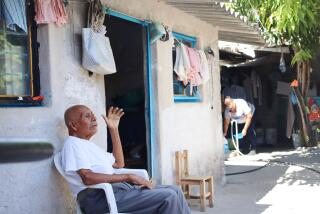Horse Sense
With all of the arm-waving and laughing going on, it looked at first like the crowd of strangers gathered Thursday in Palos Verdes was simply horsing around.
But what else would you expect when a group of psychologists trade in their leather couches for a dusty corral? And when the analyst running this counseling session is an animal?
The 18 psychologists and other mental health experts were getting an introduction to equine-assisted psychotherapy--a novel way to help troubled teenagers just say “neigh” to rebelliousness that often leads to drugs, gangs and family problems. Horse therapy helps adolescents understand themselves by forcing them to play a different role: the parent, who must find strategies to control their “child”--in this case, the horse. Advocates say it teaches communication skills, maturity and teamwork, and can cut rehabilitation time by half.
The therapy also fits in nicely with the out-of-state boarding-ranch diversion programs that have become popular with juvenile justice officers and parents at their wits’ end with their teenagers.
Horses have long been used in recreation-based programs for physically disabled children. The idea of using them as a tool to combat misbehavior is newer.
“A horse reacts to things like a human teenager does,” explained Greg Kersten, who runs an equine-assisted psychotherapy program at a Utah ranch operated by Cerritos-based Aspen Health Services.
So when a group of Kersten’s teens are ordered to make a horse go through an obstacle course and the horse balks, the youngsters end up having to see things through the horse’s eyes, not just their own.
That’s what the arm-waving psychologists in the Palos Verdes corral were doing Thursday with a 4-year-old Welsh pony named Magic. The pony portrayed a teenager. And the fence-rail obstacle the pony was supposed to jump over represented going to school, a common point of disagreement in some homes. Could they make the horse jump?
The psychologists first tried holding hands and encircling the animal, but it broke through their ranks. Then they unsuccessfully tried rushing it to scare it into jumping over the obstacle.
Finally, they formed a V and calmly maneuvered the pony over the horizontal pole positioned in the center of the corral.
“We had to have a united front to succeed. It took constant reevaluation and modifying of our approach,” said Malibu youth ranch program operator Rhonda Bryant in a debriefing session conducted afterward by Kersten in the shade of a mulberry tree next to the corral.
San Pedro therapist Carolyn Bojorquez noted that the pony “got very frightened when we backed her into a corner” at first.
Said Tom Burns, a Cerritos psychologist of the finally successful motivation effort: “We made it easier for her to decide to go to school.”
Kersten lined up bales of hay and buckets of apples in two other demonstrations. In those, the psychologists were asked to make the pony walk through “addiction alley” without stopping to nibble on the hay or gobble down the fruit.
Both times, the horse succumbed to temptation.
“That’s considered a slip, not a relapse,” joked onlooker Bill Beacham, an Irvine psychologist who heads an anti-drug center.
Kersten pointed out that the pony was able to take its first bite when one of the two people holding its reins suddenly yanked the rope, causing the person on the other side to lose her balance and loosen her grip.
“How many times does one parent negate what the other says to a teenager?” he said. “This is a great metaphor about what life’s all about.”
Kersten, 37, who grew up on a Nebraska ranch and is a certified addictions counselor, said he started his equine-therapy system eight years ago by accident.
*
He was an inner-city youth counselor in Washington, D.C., and moonlighting as a horse trainer to supplement his income. When his young charges asked him about his boots and jeans, he invited them to come see the horses in exchange for helping clean stalls.
Horse therapy at Aspen’s Loa, Utah, ranch is expensive: $3,950 a month. But teenagers who have experienced say it works.
“I was skeptical at first. I thought horses were only to ride,” said Brian Aurness, 18, who spent eight months on the ranch a year ago to deal with family problems at his West Los Angeles home. “But it’s amazing how similar horses and humans are.”
Sixteen-year-old Cory VanFleet, another West Los Angeles resident who earlier this year completed an 11-month stint at the Utah ranch dealing with family and drug problems, said horses have helped change his life.
“I was stubborn and impatient,” VanFleet said. “I learned to observe rather than talk. You watch these horses and they’ll tell you what you are doing wrong.”
Aurness and VanFleet helped set up Thursday’s demonstrations, which were organized by Natalie Keese, a Torrance juvenile diversion counselor who lives in Palos Verdes. She said she has sent two young offenders to Utah for equine-assisted therapy and seen the changes in them.
“It works. I’m a believer,” she said.
Maybe, she indicated, it is possible to lead a horse to water and make him drink.
More to Read
Start your day right
Sign up for Essential California for news, features and recommendations from the L.A. Times and beyond in your inbox six days a week.
You may occasionally receive promotional content from the Los Angeles Times.







